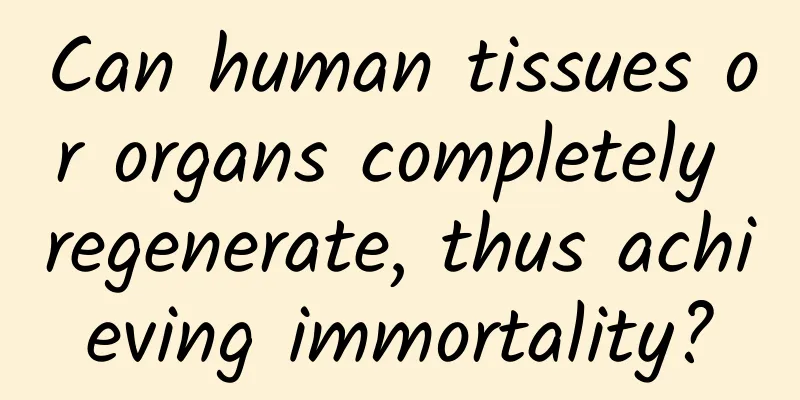Is it possible to reverse aging?

|
Staying young forever is everyone's dream, but the unexpected arrival of aging makes everyone feel helpless. So is there any way to fight aging? As someone who has been engaged in aging research, I think it is still difficult to come up with the best anti-aging method within the current scope of knowledge, but I firmly believe that with further in-depth research, a breakthrough in the aging problem is just around the corner. Today, I will share with you the manifestations, influencing mechanisms, and coping methods of aging. 01. Two major manifestations of aging For most people, the phenotype of aging can be seen with the naked eye. We can summarize it into two types: One is the appearance of aging. For example, as we age, our skin is often the first to show signs of aging. Not only does the elasticity and luster of the skin change, but wrinkles also appear, which makes many people worry. As an attachment to the skin, the hair also begins to show corresponding aging, and white hair begins to appear intermittently. Some people even experience the annoying situation of hair loss. Of course, our bones also show obvious signs of aging. The other type is internal aging. I believe you must have felt that as we age, our immunity has obviously declined. We have changed from being immune to all kinds of poisons to needing protection from the slightest disturbance. Otherwise, even a change in the weather may cause a cold, and various diseases have also increased. This is actually due to the decline in immunity. As for lack of energy, it is even more obvious. In the past, I would be full of energy the next day after staying up late to work overtime, but now I will be in a bad state of mind the next day if I procrastinate a little. It can be said that these are all signs of aging that we can all feel, but from a scientific perspective, aging often has a deeper mechanism - scientific research has found that whether it is external aging or internal aging, the root cause is aging at the cellular level. The following is a detailed introduction. 02. What factors lead to aging? This review on aging, "The hallmarks of aging", from the top international biology journal "Cell", can represent the current overall understanding. In fact, one picture can represent the entire text, as shown below. These are the nine major factors currently believed to cause aging, namely genomic instability, telomere attrition, stem cell failure, epigenetic changes, loss of protein homeostasis, nutrient sensing disorders, mitochondrial dysfunction, senescent cell clearance disorders, and changes in intercellular communication. 03. Introduction to the nine factors 1. Genomic instability As we all know, the genome is the core component of our cells. Everything that follows our body starts from the genome. From the moment the fertilized egg is formed, the genome begins to be transcribed into various RNAs and translated into proteins, and then these proteins form our organelles, cell nuclei, and cells. Of course, DNA replication itself is also a copy of the genome. However, the genome is not Iron Man. It suffers various damages within the cell, including exogenous stimuli such as oxygen free radical damage, and endogenous damage such as random genome replication errors. With aging, these damages increase, resulting in genomic instability. If there is a problem at the source, then the follow-up is naturally difficult to say. 2. Telomere attrition I believe that many people have learned this in middle school. There is a cap-like structure at the top of the chromosome, called telomere. Telomere can be said to be the timer of the cell. Every time the cell divides, the telomere shortens. When the telomere shortens to the point where it can no longer be shortened, the cell can no longer divide and a process called programmed cell death is initiated, and the cell dies. It is currently believed that an ordinary cell can only divide about 50 times in its lifetime, which is the Hayflick limit. 3. Stem cell exhaustion Stem cells are cells with a high potential for self-differentiation and renewal. The constant replacement of cells in our body comes from stem cells (all cells in hair, skin, blood, etc.). However, the problem is that stem cells will age as we age. When these stem cells age, they can no longer continue to make up for the consumption of body cells in large quantities, and eventually, the individual ages and dies. 4. Epigenetic alterations Epigenetics may be unfamiliar to many people. It is a modification of the genome without affecting the DNA sequence. This change can not only affect the development of the individual, but can also be inherited. At present, our research on epigenetics is not thorough, but at least there is enough evidence to show that our daily behaviors can also have epigenetic effects, leading to changes in the genome, and the accumulation of such changes will cause aging. 5. Loss of proteostasis The homeostasis of an organism is not just DNA, but also includes the proteins in the cells that mainly carry out life activities, whether it is various catalytic enzymes or various immune substances in our body, mainly proteins. As the most basic executor of biological functions in organisms, protein homeostasis is essential for the basic activities of cells. When protein homeostasis is out of control, it will also cause aging. 6. Deregulated nutrient sensing We cannot live without nutrients, and all cells in the human body can sense and respond in a fluctuating manner. However, if the cell's nutrient sensing is lost, it will lead to uncontrolled cell growth. Regulatory signals from nutrients such as carbohydrates and amino acids tightly regulate cell proliferation, but can also lead cells astray, such as into obesity or malignant tumors. 7. Mitochondrial dysfunction Mitochondria are the energy factories of our bodies and the sites where eukaryotic organisms carry out oxidative metabolism. The nutrients we ingest are ultimately oxidized in the mitochondria to release energy. However, the process of mitochondrial energy production itself will also release a large number of free radicals, which will cause great damage to the mitochondria and cause problems in the body's energy system. 8. Cellular senescence Cells are the basic components of the body. If something goes wrong with the cells themselves, it will be troublesome. Cell aging is a very special situation, that is, normal cells will go through the stages of undifferentiation, differentiation, growth, maturity and apoptosis. However, some cells will enter a special situation, that is, aging. The aging cells will occupy the place and will not be replaced by new cells, eventually causing the cells throughout the body to gradually age. 9. Altered intercellular communication As a multicellular individual, communication and cooperation between cells is crucial. The information exchange between cells includes direct transmission and indirect transmission, such as fluid transmission and contact transmission. Once the information exchange between cells changes, the cell function will be damaged, and finally the body will be affected. The above nine factors are the current basic understanding of the aging mechanism. I have made a brief introduction and you can go to the literature to read it. 04. How to deal with the nine factors? Of course, some people have expanded and interpreted it. For example, Greg Macpherson, a cell biologist from New Zealand, published a book called "HARNESSING THE NINE HALLMARKS OF AGING" (Chinese name: "Scientific Anti-Aging, Nine-Dimensional Repair Code of Cells"), which explains these nine factors and countermeasures in detail, and summarizes the "Nine-Dimensional Cell Theory" into three levels, as shown below: Specifically, these three levels have their own characteristics: DNA damage - an important source of this damage is that our bodies are constantly undergoing the oxidative phosphorylation process for energy supply, and the released oxygen free radicals attack DNA uncontrollably, leading to changes from the genome, telomeres to epigenetics. Cellular energy consumption and decreased repair capacity - this is mainly concentrated in changes in our energy factory mitochondria and changes in intercellular communication. A typical example is the important branch nicotinamide adenine dinucleotide NAD+ in the cell, which is commonly known as coenzyme I. It is the key to connecting the tricarboxylic acid cycle and the respiratory chain, and is also a coenzyme for many dehydrogenases in the body. It will become less and less with age, of course, also including the exhaustion of stem cells. The decline in cell autophagy ability and the accumulation of senescent cells are important factors that lead to the accumulation of senescent cells in our body. It should be noted that senescent cells, which hardly die, will always stay in that position, resulting in the inability to be replaced. They will also release some aging-related factors, affecting the adjacent healthy cells and causing further aggravation of aging. Now that we have understood these aging mechanisms, coping with aging is often also targeted at these factors. For example, enhancing the cell's repair mechanism, repairing DNA, repairing proteins, etc. Therefore, there are now many strategies to enhance these repair mechanisms, hoping to improve the cell's repair process and restore the cells to normal. Another idea is to replace the idea. Since the human body has stem cells that can proliferate indefinitely, can stem cells be activated? In fact, this is the current research on artificially induced pluripotent stem cells. This idea is indeed very good, and I also have high hopes for it. However, there is currently a problem in this field. The artificial induction of pluripotent stem cells requires the use of viruses and carcinogenic factors, which leave potential risks of infection and cancer. Therefore, in recent years, using better methods to realize stem cells has been a research hotspot. Although there have been some progress, these problems have not been completely solved. Of course, in the field of medical health, it is often not necessary to involve such specific pathway mechanisms as mentioned above, but to look for some potentially effective drug ingredients. For example, there are ingredients such as 2-Hoba, NMN, and fisetin on the market, and some experiments have also demonstrated these results. 05. How to deal with aging in daily life? However, for daily life, it may be very effective to maintain good living habits. 1. Proper sleep The human body is regulated by the circadian rhythm, which is also the content of the Nobel Prize in 2017. Nowadays, many people have the habit of staying up late, some stay up late to work overtime, some stay up late to watch TV series, and some people are simply used to staying up late. However, as a member of the biological species, we cannot fight against the power of evolution, so it is necessary to maintain a reasonable sleep and reduce staying up late. In fact, when we sleep, the brain not only gets a rest, but also increases the removal of metabolic waste from the brain. If we disrupt it, it will also affect the removal of metabolic waste from the brain. 2. Healthy diet A balanced diet is what health agencies in various countries have been advocating. This is also supported by a large amount of population data. We must ensure that we have a combination of meat and vegetables, and we must consume carbohydrates, fats, proteins, and fiber. In fact, in many cases, the nutrients we need mainly come from food. For example, vitamin C is actually a well-known antioxidant that can effectively remove free radicals from our bodies. For another example, several scholars involved in the study of Nature Medicine magazine found that a natural substance found in many fruits and vegetables, fisetin (also known as fisetin, Fisetin), can fight free radicals and has a significant positive effect on improving health and prolonging life. I believe that there are far more effective ingredients in food for aging than these. 3. Exercise Life lies in exercise. This philosophical saying actually has scientific truth behind it. Exercise is very effective in building a healthy body and resisting aging. Many times, one of the important reasons why people cannot live long is disease. Exercise has a very obvious effect on many diseases, especially metabolic diseases. For example, lipids, an important factor in causing diabetes, coronary heart disease and stroke, can be reduced to a certain extent through exercise. Overall, research on aging is still in its infancy. Although there are some signs of hope, more evidence is needed to determine what the future will be like. |
<<: What is the difference between "sand" and "grit"? You should know some scientific knowledge!
Recommend
Cat meme video goes viral! What is the magic of this video for young people?
Recently, various official accounts have been pos...
Case analysis of gamification operation strategy!
This article will help you inspire gamification m...
Let’s talk about the three common mainstream promotion methods of Taobao customers
Today I want to talk to you about the common ways...
Can eating konjac help you lose weight? Pay attention to these two points!
01 Why is konjac so low in calories? Konjac has a...
How to report fraudulent mini-programs? How to file a complaint on WeChat Mini Program?
Nowadays, people buy products through many channe...
Congratulations to Chinese scientists! New breakthroughs in 2023
A century of change Technological innovation is t...
2022 Open Traffic Password Baidu Cloud Download
: : : : : : : : : : : : : : :...
How to promote forum? How to post promotion in forums?
As a webmaster, who doesn’t want to make a name f...
How to locate a Tik Tok account? 3 new routines!
One writer once said: "Go deeper into the ar...
Analysis and Extension of Java Dynamic Proxy Mechanism
introduction The emergence of Java dynamic proxy ...
Is there any hope for Intel's 4G chip?
According to media reports, Intel recently announ...
Test Engineer's Handbook: Challenges and Opportunities
[[127980]] As testing is increasingly valued in t...
How to systematically design online and offline brand activities?
Different from daily operational activities, offl...
Three serious misunderstandings about information flow advertising targeting. Whoever steps on them will suffer. Let’s take a look…
After reading this article, I hope you can improv...
The Bubble and Truth of Internet+
Since the release of the government report at the...









